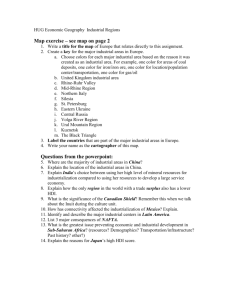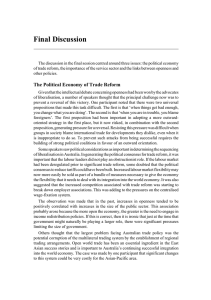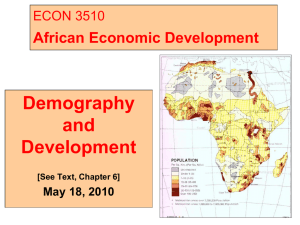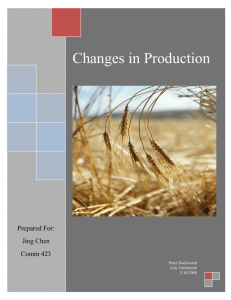Possible Essay Topics for Final Examination in ECON 320 Spring
advertisement
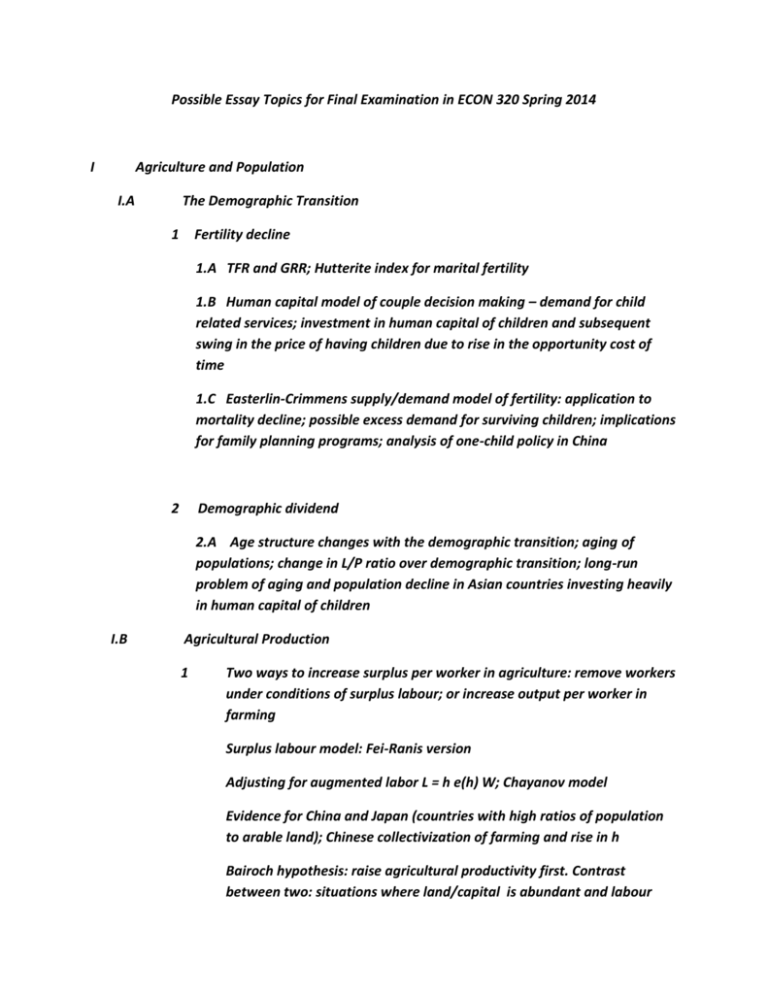
Possible Essay Topics for Final Examination in ECON 320 Spring 2014 I Agriculture and Population I.A The Demographic Transition 1 Fertility decline 1.A TFR and GRR; Hutterite index for marital fertility 1.B Human capital model of couple decision making – demand for child related services; investment in human capital of children and subsequent swing in the price of having children due to rise in the opportunity cost of time 1.C Easterlin-Crimmens supply/demand model of fertility: application to mortality decline; possible excess demand for surviving children; implications for family planning programs; analysis of one-child policy in China 2 Demographic dividend 2.A Age structure changes with the demographic transition; aging of populations; change in L/P ratio over demographic transition; long-run problem of aging and population decline in Asian countries investing heavily in human capital of children I.B Agricultural Production 1 Two ways to increase surplus per worker in agriculture: remove workers under conditions of surplus labour; or increase output per worker in farming Surplus labour model: Fei-Ranis version Adjusting for augmented labor L = h e(h) W; Chayanov model Evidence for China and Japan (countries with high ratios of population to arable land); Chinese collectivization of farming and rise in h Bairoch hypothesis: raise agricultural productivity first. Contrast between two: situations where land/capital is abundant and labour scare or cases where labour is abundant and land/capital scare. Application to green revolution technological change in densely populated Japan as opposed to North America and parts of Europe. Reasons why following Russian collectivization model created problems for Chinese agriculture during 1950s, 1960s, and 1970s. 2 Land reform Landlordism: types (sharecropping, land rent, hired labour) – risk sharing Positive aspects of landlordism: providing capital, advice on improving output Negative aspects: debt peonage (debt cycles), status differences II Capital Accumulation and Total Factor Productivity Growth II.A Financial depth and types of financial mechanisms (equity markets versus banks) – why is financial depth associated with income per capita (cause, effect, or mutual interaction?) II.B Three generations of models dealing with capital accumulation, investment and savings 1 Harrod-Domar: g(Y) = s/v, linear, assumes marginal capital – output ratio equals average capital-output ratio, hence marginal product of capital constant; use by World Bank 2 Solow model: Four parameters (A, s, n, and б) Convergence issues: sigma and beta convergence; conditional convergence. Why does capital not flow to places where the capital-labour ratio is very low? 3 II.C Endogenous growth model; linear, learning by doing, capital vintage and savings, knowledge as part of capital, knowledge as a pure public good Sources of growth accounting: estimating contribution of total factor productivity and accumulation II.D 1 How do you estimate total factor productivity growth? 2 The arc of total factor productivity growth 3 Why was total factor productivity growth so slow in China between 1950 and 1978? Infrastructure: Coordination problems Example: the supply and demand for education Examples of under and over investment in education Japan: infrastructure driven growth model III Poverty, Income Distribution, Failed States and Government Policy III.A Measuring poverty and income distribution 1 Lorentz curve, Gini coefficient and rich/poor ratios of income shares and consumption shares 2 Kuznets hypothesis: inequality rises, then falls Two theories: wage differentials expand with industrialization; or urbanization 3 Other poverty measures: Human development index (HDI) – how defined and calculated? Sen’s justification for use of HDI BSL – biological standard of living BSL = f(NNI) NNI = net nutritional intake (gross nutritional intake minus decrements for infectious disease incidence and child labour input III.B Failed States Nation-states emerging in waves: when and why? Ethno-linguistic fragmentation and failed states in post-1950 period III.C Washington consensus and neo-liberalism Democracy first, then growth (or) growth first, then democracy Is this applicable to China? III.D Bureaucratic Insulation Corruption problem Bureaucratic insulation and industrial policy in Japan MITI policies: sunrise and sunset industries, recession cartels, targeting, driving down the price of foreign technology, overcoming market failures (example of computer industry) Industrial policy may be good for catch-up growth but not afterward: reasons IV Openness and Diversity IV.A Types of openness Openness and size of a country IV.B Trade openness Historical pattern to global trade openness: 1870 to 2000: Importance of technology and international economic order Regional and global institutions: UN, IMF, World Bank, WTO The WTO: universal MFN and preferential trade agreements IV.C Two theoretical approaches to analyzing trade Comparative advantage model: relative prices, domestic and international – welfare gains from trade Gravity model: monopolistic competition and product diversity in global markets Applications to policy making IV.D Import substation industrialization to export promotion: East Asia The flying geese model/product cycle model Keiretsu and chaebol in Japan and South Korea IV.E Import substitution industrialization without export promotion: Latin America





